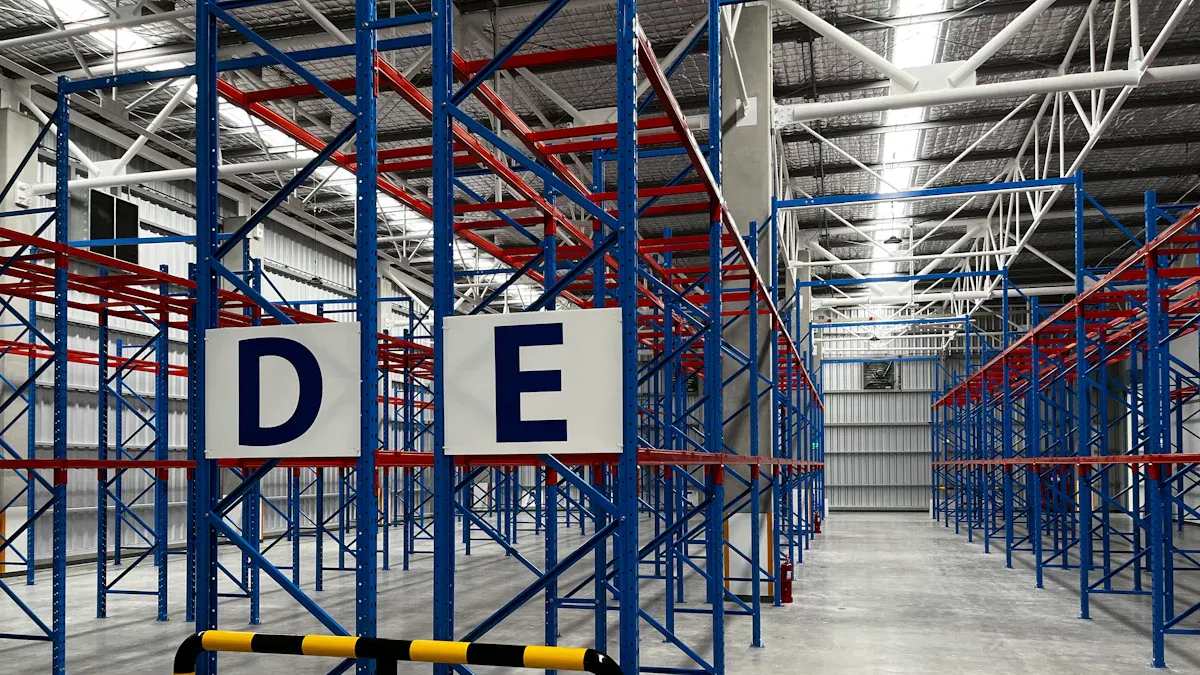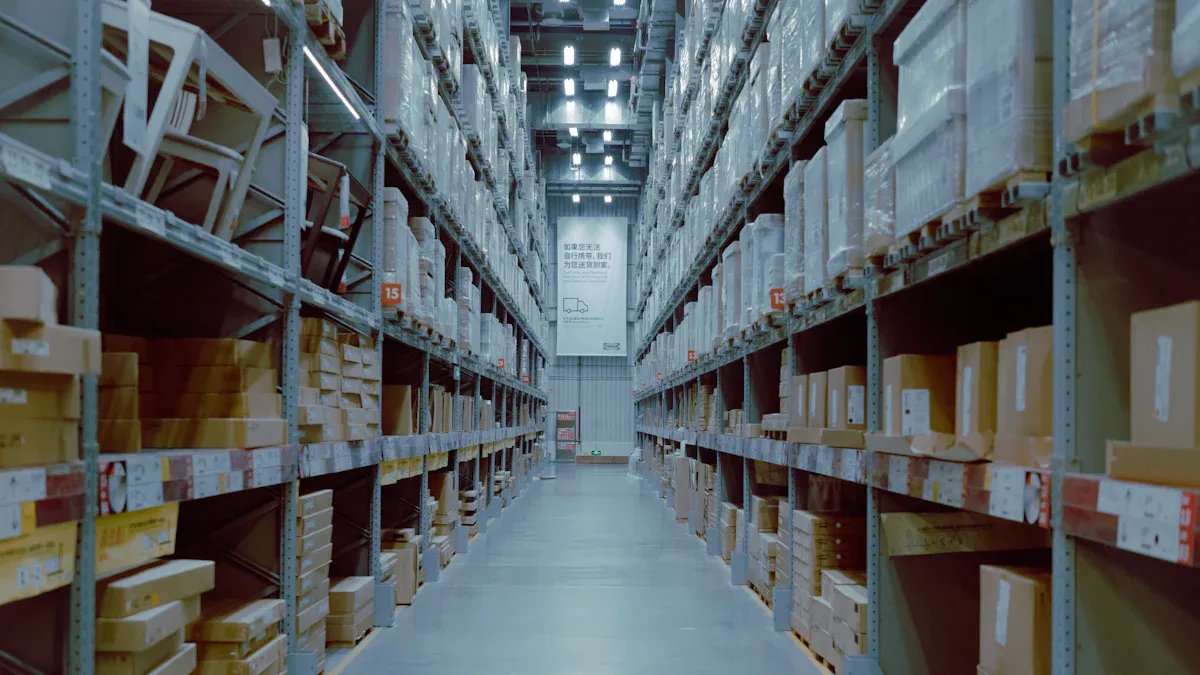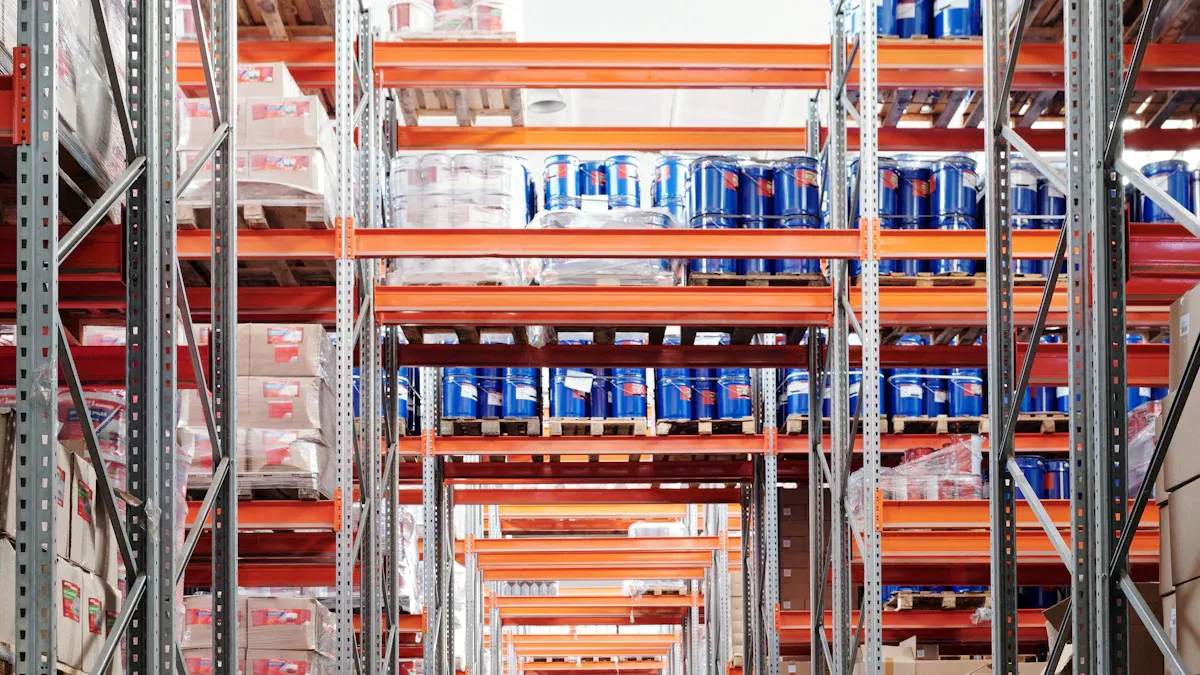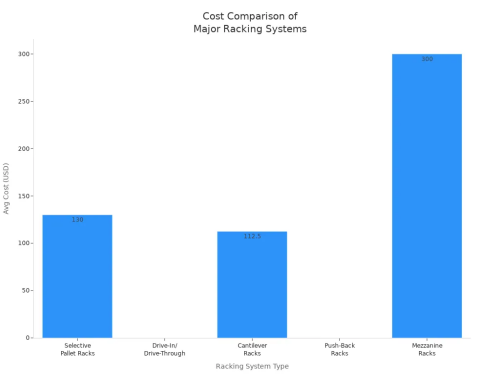
货架系统有助于保持仓库物品整洁有序,还能节省空间,提高工作效率。托盘货架系统可使仓库的存储量比单纯堆放在地面上多出40%。主要类型包括托盘货架、小件物品货架以及用于不同物品的专用货架。
|
类别 |
描述 |
|---|---|
|
托盘架 |
支撑托盘以进行大量存储 |
|
搁架 |
保留盒子和散落的物品 |
|
悬臂式货架 |
存放长或形状奇特的物品 |
|
专用货架 |
适用于地毯、轮胎或鼓 |
托盘货架系统有助于存储更多物品,并通过保持物品整洁和节省空间来加快工作速度。
不同类型的货架适用于不同的工作:选择性货架可让您轻松拿到物品,驶入式货架可为大组物品节省空间,而托盘流动货架则通过先进先出 (FIFO) 的旋转帮助优先移动易腐烂货物。
选择合适的货架系统取决于您拥有多少库存、存储什么类型的产品、仓库大小以及移动物品的频率以确保工作安全和高效。

托盘货架系统 在大多数仓库中都非常重要。这些系统有直立的框架和横梁来支撑托盘。可调节托盘货架非常灵活。工人可以上下移动横梁。这有助于适应不同尺寸的托盘或产品。当库存变化很大时,企业会倾向于使用可调节托盘货架。
托盘货架系统种类繁多,包括选择性货架、双深货架、驶入式货架和托盘流动货架。每种货架类型都能满足不同的存储需求。选择性货架可让工人快速拿到每个托盘,非常适合快速移动的产品。双深货架存储量更大,但更难拿到。驶入式货架和贯通式货架最适合存放大量相同类型的物品。
|
货架系统类型 |
主要特点 |
库存周转 |
最佳用例 |
|---|---|---|---|
|
可调节托盘货架 |
灵活的梁高度,易于重新配置 |
不适用 |
普通仓储、库存变更 |
|
紧凑型货架 |
高密度,节省占地面积 |
后进先出/先进先出 |
大量存储,空间有限 |
|
托盘流动货架 |
重力滚轮,自动库存旋转 |
先进先出 |
易腐烂物品,严格库存控制 |
|
移动式货架 |
货架在轨道上移动,一次打开一个通道 |
不适用 |
冷藏、空间优化 |
静态托盘货架的搁板不会移动,适合存放重型或长期货物。动态托盘货架利用重力或滚轮来移动货物。动态货架(例如托盘流动货架)可以节省空间并加快拣选速度。紧凑型货架(例如移动式货架或堆叠式货架)有助于节省空间并可根据需要进行更换。
优点:
可调节托盘货架灵活、易于更换。
紧凑型货架可存储更多物品并节省空间。
货架系统适用于许多行业,例如零售和医疗保健。
缺点:
一些货架需要特殊的工具或培训。
紧凑型货架可能会使某些托盘难以拿到。
动态机架的安装和维持工作成本可能更高。
典型应用:
仓库和配送中心
食品、药品冷藏
材料和成品制造工厂

现代仓库使用不同类型的货架来保持货物有序存放。这些货架可以帮助工人更快地完成工作并节省空间。下表列出了最常见的货架类型及其在2024年的使用情况:
|
托盘货架类型 |
市场地位/用途 |
市场份额/增长洞察 |
|---|---|---|
|
选择性托盘货架 |
全球范围内使用最为广泛;具有极佳的可访问性和与物料搬运设备的集成性。 |
预计预测期内最大的收入贡献者。 |
|
免下车和免下车通道 |
2024 年占据全球市场主导地位;通过减少过道来最大化空间;适用于后进先出 (LIFO) 和先进先出 (FIFO)。 |
2024 年市场占有率高;空间优化的首选。 |
|
后推式货架 |
在城市/高租金地区,高密度存储越来越受到青睐。 |
随着免下车式和托盘流动系统的出现,这一细分市场也在不断增长。 |
|
托盘流动货架 |
预计高密度存储系统具有较高的复合年增长率。 |
预计仓库货架市场将呈现最高的复合年增长率。 |
|
悬臂式货架 |
用于长件或大件物品;属于细分市场类型的一部分。 |
包含在市场细分中,但不如其他市场占主导地位。 |
|
移动货架系统 |
预测期内增长最快的部分。 |
由于空间效率和自动化趋势而实现快速增长。 |
提示:全球超过61%的货架系统采用托盘货架。这使其成为大多数仓库存储的主要系统。
选择性托盘货架系统是许多仓库中最受欢迎的系统。该系统使用直立框架和横梁来搭建托盘货架。工人无需移动其他托盘即可轻松够到每个托盘。这非常适合库存量大、拣选需求高的场所。
主要特点:
直接访问每个托盘
可调节托盘货架横梁,适用于不同尺寸的托盘
支持先进先出 (FIFO) 和后进先出 (LIFO) 库存管理
与标准叉车兼容
优点:
高选择性和灵活性
对于大多数仓库来说具有成本效益
易于安装和重新配置
缺点:
由于需要通道,存储密度较低
不适合批量存储类似物品
最佳使用场景:
SKU 数量较多的仓库
冷藏、零售和制造
需要频繁访问各种产品的操作
注意:选择性货架系统是需要快速访问和快速库存变化的仓库的最佳货架系统。
双深托盘货架 可在每个货架位置存放两个托盘。该系统节省了过道空间,比选择性货架的容量高出 40%。但要取回后面的托盘,必须先移动前面的托盘,因此它采用后进先出(LIFO)的原则。
主要特点:
每个货架深两个托盘
需要配备伸缩叉的专用前移式叉车
可调节托盘货架设计,满足不断变化的需求
优点:
比选择性货架具有更高的存储密度
适合存储大量类似的 SKU
每个托盘的成本与标准货架相似
缺点:
选择性较低;进入后托盘的速度较慢
需要专门的设备和操作员培训
最佳使用场景:
占地面积有限且同类产品数量较多的仓库
具有足够天花板高度和畅通通道的设施
双深货架非常适合那些想要利用更多空间但仍需要存取货物的企业。
驶入式货架和驶过式货架 通过减少过道数量,节省空间。叉车可驶入货架,装载或取出托盘。
驶入式货架:
托盘存放在多个位置深的通道中
采用后进先出 (LIFO) 系统
非常适合存储大量相同产品
驶入式货架:
结构类似但允许从两端访问
支持先进先出库存管理
更适合具有多种 SKU 的仓库
|
货架系统 |
最有效的场景 |
主要优势 |
主要限制 |
|---|---|---|---|
|
驶入式货架 |
仓库空间有限,SKU 数量少,周转率高;库存同质;散装存储 |
最大程度提高存储密度;由于减少了过道空间,因此具有成本效益;装卸效率高 |
SKU 选择性有限;LIFO/FIFO 限制;空间狭小可能导致托盘损坏 |
|
驶入式货架 |
需要灵活库存管理的仓库,库存量单位多样;支持先进先出 (FIFO) 和后进先出 (LIFO) 方法 |
双重访问提高了灵活性;允许同时装载/卸载;更好的可访问性 |
存储密度较低;需要更多空间;成本较高;可能造成库存混乱 |
优点:
最大化存储密度
减少过道空间
批量存储,经济高效
缺点:
选择性有限,尤其是对于驶入式货架
托盘损坏风险更高
特定托盘的装载/卸载速度较慢
最佳使用场景:
冷藏、食品饮料和散装货物仓库
库存同质且周转率高的设施
后推式货架使用斜轨上的推车。当您添加新的托盘时,它会将其他托盘推回。该系统采用后进先出 (LIFO) 原则,每条通道可容纳 2 至 6 个托盘。
主要特点:
单通道通道
移除托盘后,托盘会自动向前移动
中等选择性
优点:
比选择性货架具有更高的存储密度
减少过道要求
适用于大批量、非日期敏感的产品
缺点:
比选择性货架更昂贵
不适合先进先出库存
仅限于统一的托盘尺寸
最佳使用场景:
租金高昂的城市仓库
大量储存类似产品的设施
后推式货架兼具存储空间和便捷存取功能。对于空间有限的仓库来说,后推式货架是明智之选。
托盘流动货架,又称动态托盘货架,利用重力滚轮将托盘从装载侧移动到拣货侧。该系统采用先进先出 (FIFO) 原则,每条通道最多可存储 20 个托盘。
主要特点:
重力驱动运动
专用装载和拣选通道
高密度存储
优点:
最大化存储容量,在相同空间内库存几乎增加一倍
降低劳动力和设备成本
改善易腐货物的库存控制
无需电力
缺点:
前期成本较高
选择性较低;接入点有限
最佳使用场景:
食品饮料、药品和高周转产品
需要严格先进先出库存控制的仓库
活动托盘货架系统有助于快速运输货物,减少错误。它们非常适合快速运输且对日期敏感的货物。

悬臂式货架适用于存放长条形、体积大或形状奇特的物品,这些物品无法放入普通货架。这种货架的臂从中心柱伸出,因此没有前立柱。
主要特点:
前部敞开,方便装卸
可调节臂以适应不同尺寸的物品
支撑重物和长物
优点:
更容易取用大件或长件物品
灵活适应各种产品长度
坚固耐用,可承受重载
缺点:
需要更宽的过道
密度低于其他类型的货架
可能需要专门的设备
最佳使用场景:
木材场、金属制造厂和家具仓库
管道、钢筋、地毯卷和大型家具的储存
悬臂式货架最适合存放木材、管道和大型家具等物品。
移动式货架系统将货架安装在轨道上,以便货架仅在需要时移动并打开通道。该系统摆脱了固定通道的限制,更有效地利用了空间。
主要特点:
货架在轨道上移动,以打开通道
手动或自动控制
可调节托盘货架选项,满足不断变化的需求
优点:
存储容量增加 50-80%
最大限度地提高小型仓库的空间利用率
支持自动化和高密度存储
缺点:
初始投资较高
需要平坦、均匀的地面来安装轨道
如果同时需要多个通道,可能会减慢通行速度
最佳使用场景:
冷藏库、档案馆和城市仓库
空间有限且存储需求高的设施
移动式货架系统可帮助企业在相同区域内将存储空间增加一倍或两倍。对于成长型企业而言,移动式货架系统是明智之选。
纸箱流动式货架是一种活动托盘货架,利用重力滚轮或轮子将纸箱从装载侧移动到拣货侧。该系统非常适合小包装箱和大批量拣货。
主要特点:
纸箱或手提箱的重力进料通道
后部装载,前部拣选
支持先进先出库存管理
优点:
减少拾取路径高达 65%
提高拣选速度和准确性
增强人体工程学和安全性
缺点:
不适合存放过重或过大的物品
成本比静态货架更高
最佳使用场景:
电子商务、配送中心和零售仓库
需要快速、准确订单拣选的操作
纸箱流动货架使拣货和补货更加快捷方便。它是高效仓库货架系统的关键组成部分。
仓库货架可以满足多种存储需求。有些货架适合快速拣选。其他货架,例如托盘流动货架,则非常适合快速移动的物品。
看看你的库存有多大、有多重。
考虑一下您将物品搬进搬出的频率。
检查仓库的大小和形状。
选择适合您取货频率并确保物品安全的货架系统。
|
货架类型 |
最佳应用 |
|---|---|
|
选择性 |
SKU 数量多,快速拣选 |
|
免下车影院 |
大量相同产品 |
|
托盘流 |
先进先出(FIFO),容易损坏的物品 |
|
悬臂 |
长条状或形状奇怪的物体 |
提示:为小型仓库选择合适的货架系统可以帮助您更好地工作并确保安全。
为了获得最佳效果,请考虑您的业务未来如何发展。选择能够随库存变化而变化的货架系统。
选择性托盘货架系统能够安全地承载重物。它们提供强有力的支撑,并有助于防止事故发生。这保障了仓库工人的安全。
移动式货架系统在小型仓库中沿轨道移动货架。每次只打开一个通道。这种设置可以让您在更小的空间内存储更多物品。
托盘流动货架系统使产品在冷藏库中保持流动。它们利用重力滚轮推动货物向前移动。这有助于实现先进先出的库存周转。